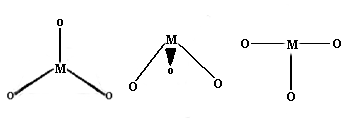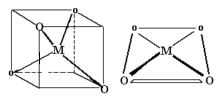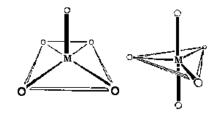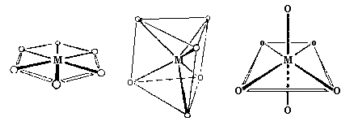
The total number of points of attachment to the central element is termed the coordination number and this can vary from 2 to as many as 16, but is usually 6.
This arrangement is not very common for first row transition metal ion complexes and
some of the best known examples are for Silver(I).
For instance, a method often employed for the detection of chloride ions involves the
formation of the linear diamminesilver(I) complex.
The first step is:
Ag+ + Cl- -> AgCl (white ppt)
and to ensure that the precipitate is really the chloride salt, two further tests must be done:
AgCl + 2NH3 -> [Ag(NH3)2]+ + Cl- and
Cl- + [Ag(NH3)2]+ + 2HNO3 -> AgCl(re-ppts) + 2NH4NO3
The reaction of a bidentate ligand such as 1,2-diaminoethane with Ag+ does not lead to chelated ring systems, but instead to linear two coordinate complexes. One reason for this is that bidentate ligands can NOT exist in trans arrangements that is can NOT span 180 degrees.
Once again, this is not very common for first row transition metal ions.
Examples with three different geometries have been identified: 
Well known for main group species like CO32- etc, this geometry has the four atoms in a plane with the bond angles between the ligands at 120 degrees.
More common with main group ions.
The first example of a T-shaped molecule was found in 1977.
Two different geometries are possible. The tetrahedron is the more
common while the square planar is found almost exclusively with metal ions having a d8
electronic configuration.

The chemistry of molecules centred around a tetrahedral C atom is covered in organic courses. To be politically correct, please change all occurrences of C to Co. There are large numbers of tetrahedral Cobalt(II) complexes known.
This is fairly rare and is included only because some extremely important molecules exist with this shape.

The structure of [Cr(en)3][Ni(CN)5] 1.5 H2O was
reported in 1968 to be a remarkable example of a complex exhibiting both types of geometry
in the same crystal.
The reaction of cyanide ion with Ni2+ proceeds via several steps:
Ni2+ + 2 CN- -> Ni(CN)2
Ni(CN)2 + 2 CN- -> [Ni(CN)4]2-
orange-red
log(beta4) = 30.1
[Ni(CN)4]2- + CN- -> [Ni(CN)5]3-
deep red
Oxovanadium salts (Vanadyl, VO2+) often show square pyramidal geometry, for example, VO(acac)2. Note that the Vanadium(IV) can be considered coordinatively unsaturated and addition of pyridine leads to the formation of an octahedral complex.

Unknown for first row transition metal ions, although the arrangement of six groups in a plane is found in some higher coordination number geometries.
Most trigonal prismatic compounds have three bidentate ligands such as dithiolates or oxalates and few are known for first row transition metal ions.
The most common geometry found for first row transition metal ions, including all aqua
ions.
In some cases distortions are observed and these can sometimes be explained in terms of
the Jahn-Teller Theorem.

Three geometries are possible:

 Return to Chemistry, UWI-Mona, Home Page
Return to Chemistry, UWI-Mona, Home Page
Created March 1996. Last modified 13th March-99.
URL http://wwwchem.uwimona.edu.jm:1104/courses/IC10Kcn.html